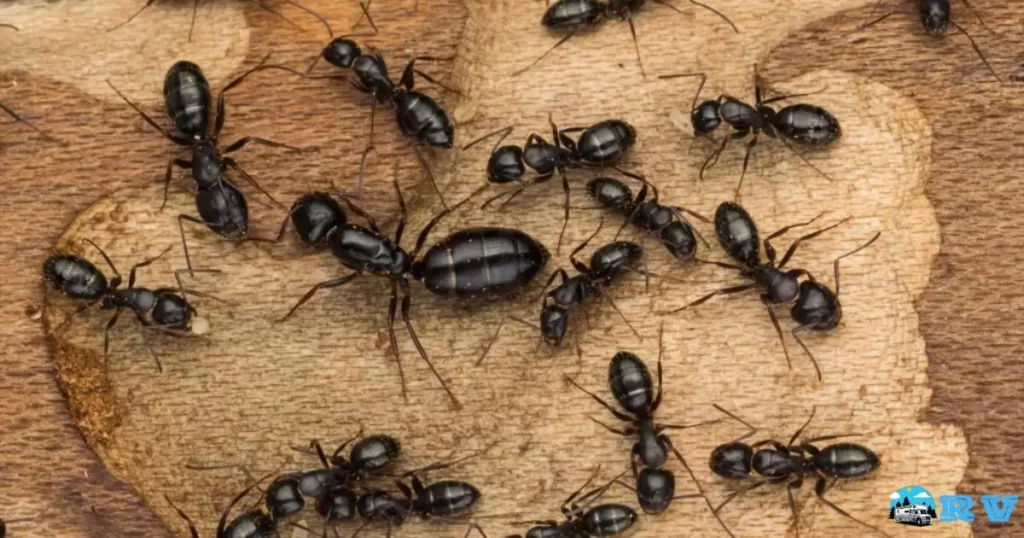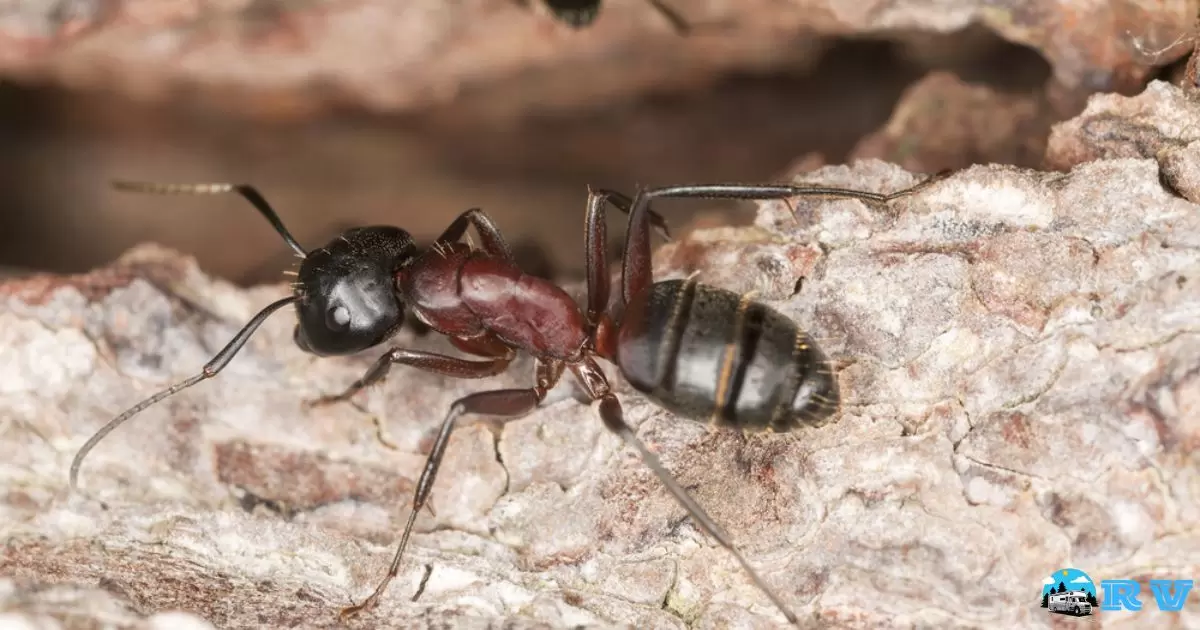Carpenter ants in your RV are destructive pests that can cause significant damage to your recreational vehicle. These ants are often attracted to the wood used in RV construction, and if left unchecked, they can weaken the structural integrity of your vehicle.
Are you tired of sharing your RV with unwanted guests. Wondering how to get rid of carpenter ants in your RV these pesky insects can make your camping trips a nightmare, but fear not, as we have some effective solutions to help you reclaim your recreational vehicle from their presence.
Carpenter ants in your RV are attracted to moisture and food sources, and they often establish nests in the wooden components of your vehicle. It’s crucial to identify their entry points and nesting areas to effectively eliminate them. By taking swift action and implementing proper preventive measures, you can ensure a pest-free environment.
Identifying Carpenter Ants in Your RV
To effectively combat get rid of carpenter ants in your RV infestations, you must first learn how to recognize them. These ants are typically larger than most common ant species and are black or reddish-brown in color. They have a segmented body, and their rear wings are longer than the front ones, creating a distinct appearance.
Carpenter ants also produce sawdust-like frass as they excavate their nests in wood, which is a clear sign of their presence. Carpenter ants are often found near moisture sources, so inspect your RV’s plumbing and areas prone to leaks. You may come across their nests in walls, ceilings, and floors. Identifying these pests early is crucial for effective elimination.
Understanding the Behavior of RV Infesting Carpenter Ants

Before you take action, it’s essential to understand the behavior of carpenter ants in your RV. These ants establish their colonies in wood, creating intricate tunnel systems within the material. They prefer damp, decaying, or softened wood, which is often abundant in RVs due to their exposure to varying weather conditions.
The worker ants forage for food and water, making your RV an attractive target if you leave out crumbs, sugary substances, or pet food. Carpenter ants can also be active at night, making their presence less noticeable during the day. Recognizing these patterns can help you effectively address the infestation.
Preventing Carpenter Ant Infestations in Your RV
Prevention is the key to maintaining a carpenter ant-free RV. Here’s a table summarizing key preventive measures you can take to safeguard your vehicle against infestations:
| Preventive Measure | Description |
| Seal entry points and gaps | Regularly inspect and seal any openings in your RV |
| Reduce moisture sources | Fix leaks, ensure proper ventilation, and keep your RV dry |
| Store food securely | Keep all food items in airtight containers |
| Regular cleaning and sanitation | Maintain a clean and clutter-free RV to minimise attractants |
| Monitor your RV’s exterior | Check for signs of carpenter ant activity outside your vehicle |
Natural Remedies for Eliminating Carpenter Ants
If you’ve identified a carpenter ant infestation, you can turn to natural remedies to eliminate them. Diatomaceous earth, a natural desiccant, can be sprinkled in their paths to dehydrate and kill them. Boric acid, mixed with a sweet bait, can be an effective poison for these ants.
Orange oil and vinegar sprays can deter carpenter ants from returning.
To create a boric acid bait, mix one part boric acid with three parts powdered sugar and place it in areas where you’ve seen ant activity. The sugar attracts the ants, and the boric acid eradicates them.
Using Chemical Solutions to Eradicate Carpenter Ants
If natural remedies don’t provide the desired results, chemical solutions can be employed. Carpenter ant baits and sprays designed for ants can effectively eliminate infestations. These products contain active ingredients that target the ants and their colonies.
Before using any chemical solution, read and follow the manufacturer’s instructions carefully. Safety precautions should take to prevent harm to humans and pets. Consider consulting with a pest control professional for the most effective and safe treatment.
Sealing Entry Points and Gaps in Your RV
Carpenter ants often find their way into your RV through small openings and gaps. Regularly inspect your vehicle for any potential entry points and seal them with appropriate materials. Common entry points include gaps around windows, doors, and vents.
It’s essential to use sealants that are suitable for your RV’s construction materials and that can withstand weather and temperature changes. By sealing these entry points, you create a barrier that prevents carpenter ants from infiltrating your vehicle.
Safeguarding Your RV Against Future Carpenter Ant Intrusions
Once you’ve successfully eliminated carpenter ants from your RV, take steps to prevent future infestations. Regularly monitor your vehicle’s exterior for signs of carpenter ant activity, such as frass or ant trails. Address any potential moisture issues promptly, and maintain a clean and organized interior to reduce attractants.
Consider placing ant baits or deterrents near your RV’s parking spot to keep these pests away. Taking these preventive measures will help ensure that your recreational vehicle remains a carpenter ant-free zone for your future adventures.
Maintaining a Carpenter Ant Free RV for Stress Free Adventures
Keeping your RV carpenter ant-free is crucial for stress free adventures. These tiny pests can cause significant damage to your vehicle’s structure. To prevent infestations, store food in sealed containers, clean up crumbs promptly, and seal any entry points.
Regularly inspect your RV for signs of carpenter ant activity, such as sawdust-like debris or the presence of pests. If you spot any issues, including how to get rid of mice in RV ceiling, address them immediately to avoid costly repairs. By taking these simple steps, you can ensure your RV remains a pest-free haven for your stress-free travels.
FAQs
How do I identify carpenter ants in my RV?
Look for large, black or reddish-brown ants with segmented bodies and longer rear wings. Their frass, which resembles sawdust, is another telltale sign.
What attracts carpenter ants to RVs?
Carpenter ants are drawn to moisture sources and food. Leaks, crumbs, and pet food can make your RV inviting to them.
Can I use natural remedies to get rid of carpenter ants?
Yes, you can use diatomaceous earth, boric acid baits, orange oil, or vinegar sprays to eliminate these ants.
How can I prevent carpenter ant infestations in my RV?
Regularly inspect and seal entry points, reduce moisture sources, store food securely, keep your RV clean, and monitor the exterior for signs of activity.
Conclusion
In your quest to rid your RV of carpenter ants, you’ve learned to identify these pests, understand their habits, and implement both natural and chemical solutions. By sealing entry points and taking preventive measures, you’re one step closer to a hassle-free travel experience.
Remember, it’s not just about getting rid of carpenter ants; it’s about keeping them away for good. With these strategies, you can maintain a carpenter ant-free RV, ensuring your adventures are stress-free and enjoyable. Go ahead, hit the open road, and make lasting memories without the worry of unwanted guests. Your RV is now your pest-free sanctuary for all your future journeys.











